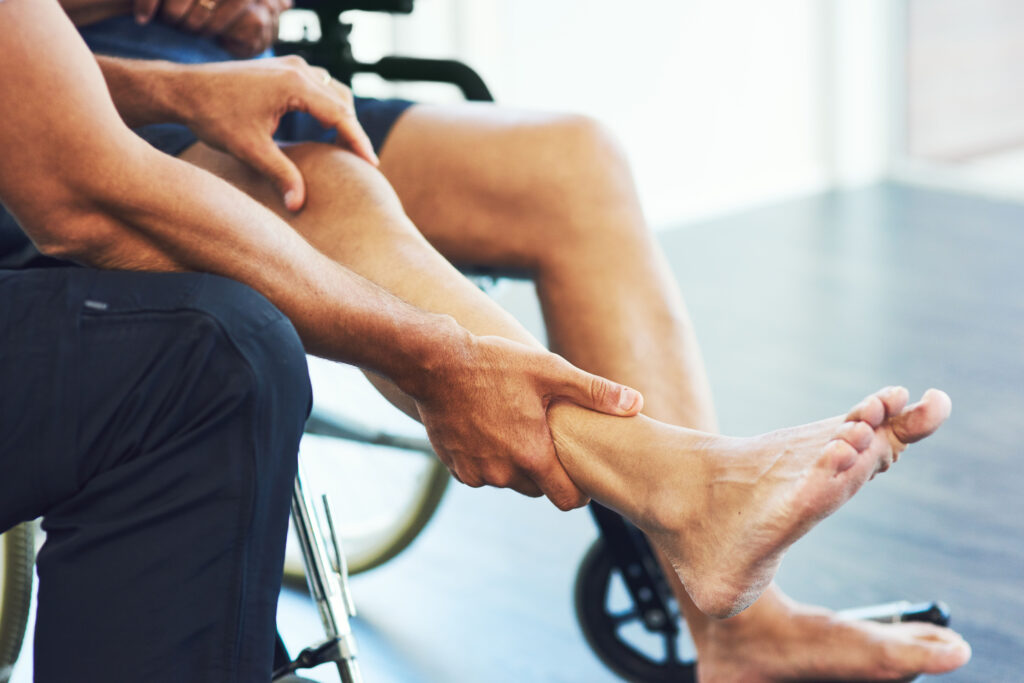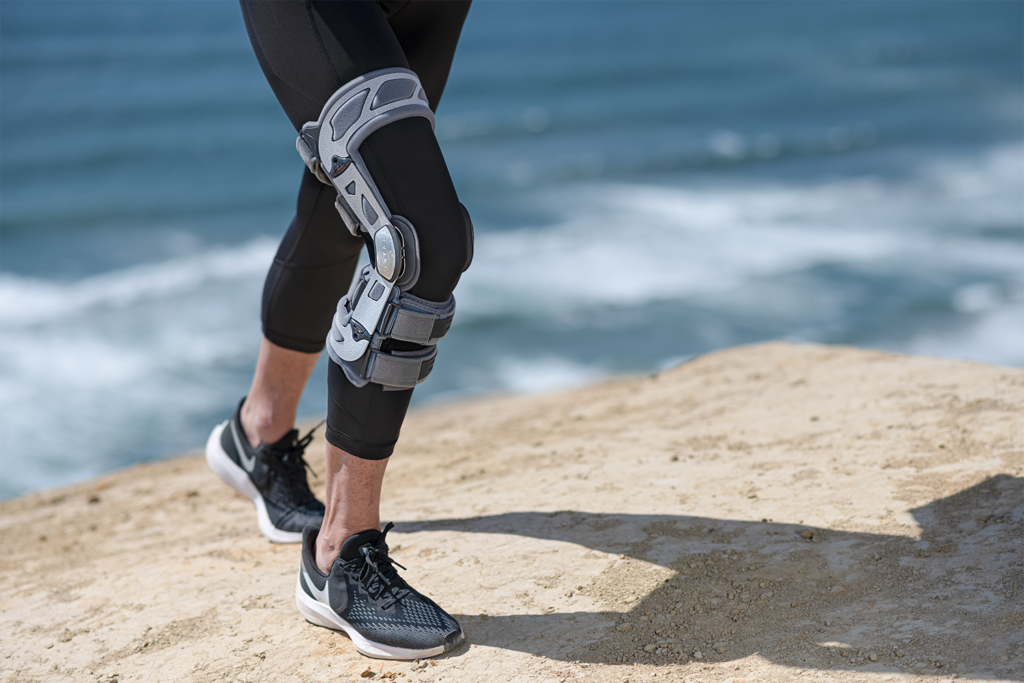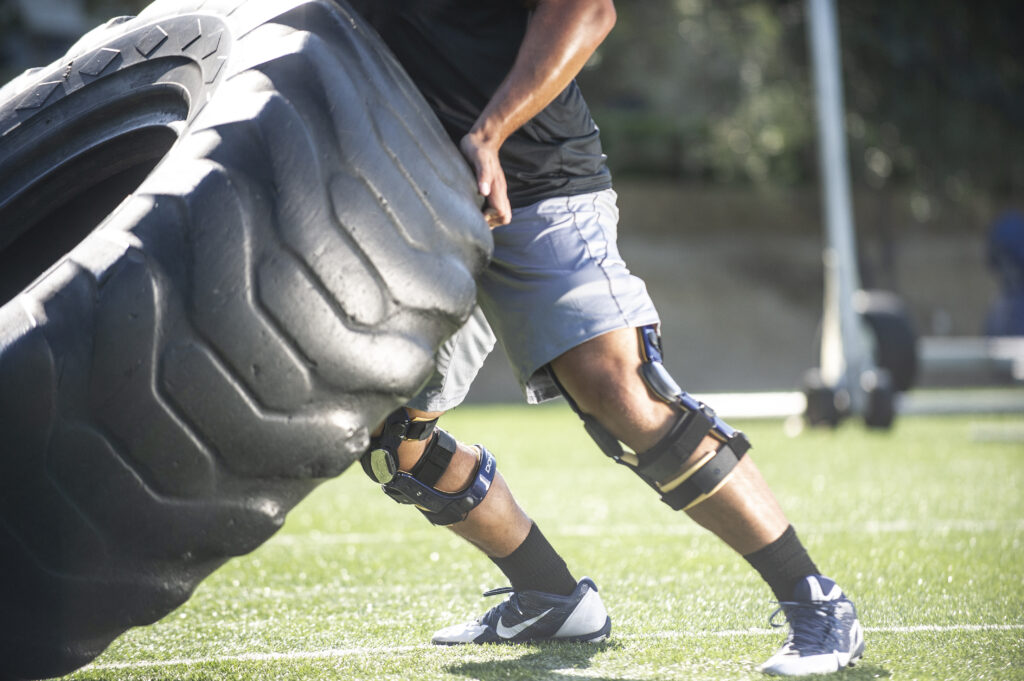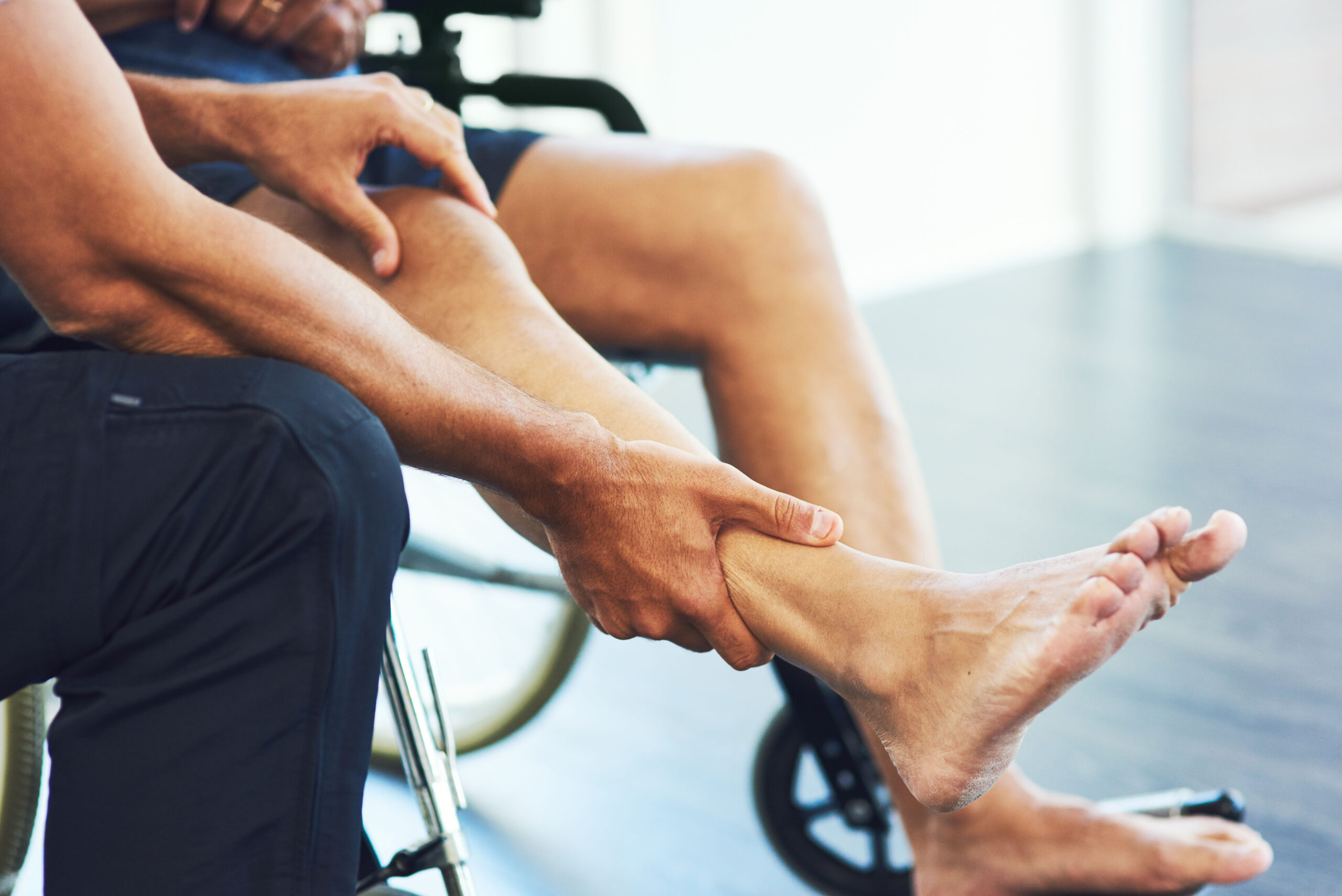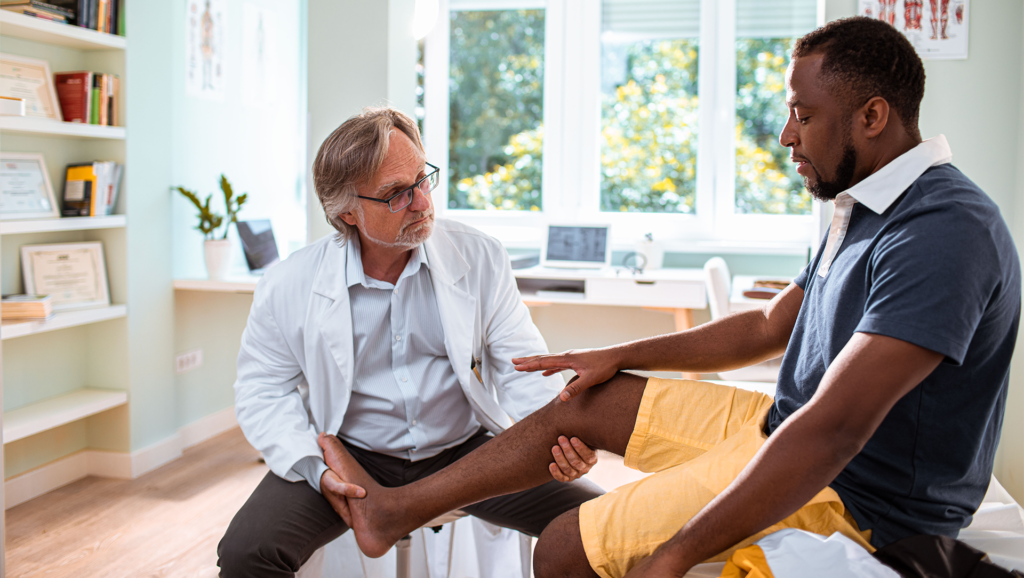
Functional bracing is a conservative treatment that involves the wearing of an orthotic brace in order to protect a joint and/or increase stability following an injury.1
Despite their widespread use, it is claimed that long-term use of these functional orthoses may also cause muscular atrophy and reduction in muscle strength.2 As a result, some physical therapists, athletic trainers, and health practitioners are reluctant to recommend functional braces due to a perception that they cause weakness in the surrounding muscle.3,4
While a complete review of the current literature would be necessary to find evidence of braces causing muscle atrophy, many recent studies demonstrate that rather than contributing to weaker muscles, bracing instead helps muscles to be more active.
What is muscle atrophy and how does it occur?
The term “muscle atrophy” refers to the loss of muscle tissue. Muscle atrophy occurs in response to a variety of stressors, including decreases in external loading and neural activation, which is often referred to as disuse.5 Disuse often occurs in clinical settings following limb immobilization and bed rest, resulting in significant loss of muscle mass and force production.
The extent of muscle atrophy under disuse conditions is variable and dependent on a variety of factors including age, the physiological function and fiber type composition of the muscle, and the degree of unloading and inactivity. Studies have shown that muscle volume can reduce by as much as 5.5% in just 7 days.6
How bracing can support the OA knee without making the muscles weaker
Knee osteoarthritis (OA) is a painful condition that can lead to a reduction in physical activity. Knee OA braces relieve pressure on the affected joint and help the patient stay mobile, but is there a risk of associated muscle loss?
Rather than finding evidence of knee OA bracing causing muscle atrophy, a number of studies instead showed that it actually helps improve muscle strength.
In a 1997 study by Matsuno et al., 17 of 20 subjects receiving brace treatment for severe medial knee OA showed improvement of symptoms and function while also increasing quadriceps strength.7
Girija et al. (2010), found that in a group of 28 subjects, after 4 weeks of wearing an OA knee brace and lateral wedge, there was an improvement in isokinetic concentric peak torque of quadriceps and hamstrings, reducing pain and functional status.8
OA bracing was shown to have neuromuscular retraining benefits for 10 patients who took part in Johnson et al.’s 2012 study.9
Hurley et al. (2012), found that increased brace use over a 6-month period does not result in muscle impairment, and even found evidence of significant improvement in hamstrings strength.10
In Larson et al.’s 2013 study, results showing increased weight acceptance and ability to be able to push off with more power suggest that the OA brace worn by the subjects, by redistributing the loading forces in the knee, aided the strengthening of muscles in the leg.11
And finally, Callaghan et al. (2016), showed a flexible patellofemoral knee support did not have an adverse effect on quadriceps maximum voluntary contraction in participants with patellofemoral joint (PFJ) OA, and also that it significantly improved arthrogenous muscle inhibition (AMI). This indicates that individuals with knee PFJ OA may consider using a flexible knee support without concern that this type of device will impair muscle strength or activation.12
How can bracing promote muscle activity in patients with patellofemoral pain or ACL injuries?
Proprioception is the body’s ability to sense its own location, movement, and actions. This ability can be impaired in patients with an anterior cruciate ligament (ACL) injury.
Research has shown that improving proprioception with bracing also improves neuromuscular control, dynamic stability, and muscle activation in patients with ACL injuries and in patellofemoral pain (PFP) patients.
In PFP patients, the vastus medialis, which is one of the four muscles that comprise the quadriceps, commonly displays atrophy.13
Sker et al. (2017), showed long-term wearing of patellar bracing increases electromyography activity of vastus medialis during mid-stance and late stance and preswing sub-phases of gait.14
Additionally, Kölle et al.’s 2020 study demonstrated that patellofemoral bracing results in an immediate decrease of pain, an earlier onset of vastus medialis and inverted vastus medialis/vastus lateralis ratio, and altered knee kinematics.15
In their 1997 study of skiers using functional knee braces following ACL injuries, Németh et al. found that skiing with a DonJoy Defiance brace caused increased proprioceptive input resulting in higher EMG activity level of the dynamic knee stabilizers and adapted motor patterns contributing to increased active knee stability.16
And Ramsey et al.’s 2003 results indicate joint stability may result from proprioceptive feedback rather than the mechanical stabilizing effect of the brace.17 None of these studies suggest evidence of ACL or patellofemoral bracing causing muscle atrophy, and instead show it helps the body’s ability to stabilize itself.
Conclusions
In summary, these studies conclude that functional bracing does not cause muscle atrophy. In fact, they show that muscles are more active with functional bracing, and more active muscles mean less atrophy.
Here are the key ways in which bracing helps muscles to be more active, and patients to lead more active lifestyles:
- Less pain means more activity. By relieving pain, bracing helps patients to stay active.
- Improved proprioception results in better movement patterns which in turn lead to more optimal muscle activation.
- Improved knee stability can boost confidence to take part in physical activity.
- Reduced AMI and less fear of movement results in an increase in muscle activity.
All of this evidence means practitioners should have no cause for concern when considering bracing for patients with knee injuries. Instead, they can be confident that functional bracing is an effective way to help their patients maintain an active lifestyle. To learn more about DonJoy’s range of functional knee bracing, visit enovis-medtech.eu
References
- Sinclair, J.K., Vincent, H. and Richards, J.D. (2017). Effects of prophylactic knee bracing on knee joint kinetics and kinematics during netball specific movements. Physical Therapy in Sport, 23, 93-98.
- Sato, N., Sekiguchi, M., Kikuchi, S., Shishido, H., Sato, K. and Konno, S. (2012). Effects of long-term corset wearing on chronic low back pain. Fukushima journal of medical science, 58(1), 60-65.
- Denton, J.M., Waldhelm, A., Hacke, J.D. and Gross, M.T. (2015). Clinician recommendations and perceptions of factors associated with ankle brace use. Sports health, 7(3), 267-269.
- Callaghan, M.J., Parkes, M.J. and Felson, D.T. (2016). The effect of knee braces on quadriceps strength and inhibition in subjects with patellofemoral osteoarthritis. journal of orthopaedic & sports physical therapy, 46(1), 19-25.
- Bodine, S.C. (2013). Disuse-induced muscle wasting. The international journal of biochemistry & cell biology, 45(10), 2200-2208.
- Kilroe, S.P., Fulford, J., Jackman, S.R., Van Loon, L.J. and Wall, B.T. (2019). Temporal muscle-specific disuse atrophy during one week of leg immobilization. Medicine and Science in Sports and Exercise.
- Matsuno, H., Kadowaki, K. M., & Tsuji, H. (1997). Generation II knee bracing for severe medial compartment osteoarthritis of the knee. Archives of physical medicine and rehabilitation, 78(7), 745–749.
- Girija, P., Eapen, C., Zulfeequer, & Kamath, S. (2010). Effect of knee support brace and lateral wedge in sole on isokinetic peak torque in osteoarthritis of the knee–a randomized clinical trial. Indian Journal of Physiotherapy and Occupational Therapy—An International Journal, 4, 25-28.
- Johnson, A. J., Starr, R., Kapadia, B. H., Bhave, A., & Mont, M. A. (2013). Gait and clinical improvements with a novel knee brace for knee OA. The journal of knee surgery, 26(3), 173–178.
- Hurley, S. T., Hatfield Murdock, G. L., Stanish, W. D., & Hubley-Kozey, C. L. (2012). Is there a dose response for valgus unloader brace usage on knee pain, function, and muscle strength?. Archives of physical medicine and rehabilitation, 93(3), 496–502.
- Larsen, B. L., Jacofsky, M. C., Brown, J. A., & Jacofsky, D. J. (2013). Valgus bracing affords short-term treatment solution across walking and sit-to-stand activities. The Journal of arthroplasty, 28(5), 792–797.
- Callaghan, M. J., Parkes, M. J., & Felson, D. T. (2016). The Effect of Knee Braces on Quadriceps Strength and Inhibition in Subjects With Patellofemoral Osteoarthritis. The Journal of orthopaedic and sports physical therapy, 46(1), 19–25.
- Callaghan, M. J., & Oldham, J. A. (2004). Quadriceps atrophy: to what extent does it exist in patellofemoral pain syndrome?. British journal of sports medicine, 38(3), 295–299.
- Salarie Sker, F., Anbarian, M., Yazdani, A. H., Hesari, P., & Babaei-Ghazani, A. (2017). Patellar bracing affects sEMG activity of leg and thigh muscles during stance phase in patellofemoral pain syndrome. Gait & posture, 58, 7–12.
- Kölle, T., Alt, W., & Wagner, D. (2020). Immediate effects of an elastic patellar brace on pain, neuromuscular activity and knee kinematics in subjects with patellofemoral pain. Archives of orthopaedic and trauma surgery, 140(7), 905–912.
- Németh, G., Lamontagne, M., Tho, K. S., & Eriksson, E. (1997). Electromyographic activity in expert downhill skiers using functional knee braces after anterior cruciate ligament injuries. The American journal of sports medicine, 25(5), 635–641.
- Ramsey, D. K., Wretenberg, P. F., Lamontagne, M., & Németh, G. (2003). Electromyographic and biomechanic analysis of anterior cruciate ligament deficiency and functional knee bracing. Clinical biomechanics (Bristol, Avon), 18(1), 28–34.

